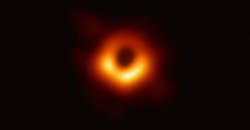NASA recently unveiled the first-ever image taken of a black hole. It showed a black hole at the center of the galaxy Messier 87, or M87, which is around 55 million light years away. That is so far away, in fact, that the shadow of the black hole—the dark signature of the event horizon, which is the point beyond which not even light can escape—is just 40 microarcseconds wide when standing on the Earth. Trying to take a picture of it see is the equivalent of trying to shoot a photo of an orange on the moon while standing on Earth.
Further complicating the task is the fact that the black hole is surrounded by a optically thick cloud of gas, so the black hole shadow can only be imaged via narrow wavelengths of light capable of piercing the cloud. Given the black hole’s distance and the wavelength of light needed, taking an image of it with a single telescope would require one that is 13 million meters wide: basically, a telescope with the same diameter as the Earth.
Since that is obviously impossible, the NASA team instead created a virtual telescope of that size by linking together eight radio observatories at six locations spread across the globe using the precise timing of atomic clocks. Gathering data with such precision from such disparate locations was an unprecedented feat, but also only the beginning of the challenge.
NASA had a large, noisy data set (collection of data), and had to dig out the images of the black hole. So it was not a photograph taken in the visual spectrum. The researchers used several types of imaging algorithms to ascertain exactly what had generated the data captured by the eight telescopes. Those algorithms were painstakingly tested by making sure they faithfully reproduced known images from data akin to the observations of M87.
After much testing and processing of the M87 data, an image finally took shape, clearly showing a bright ring surrounding a void of black. Beyond producing a first-of-its-kind image, the process let team estimate the black hole’s mass, which had been the subject of some debate. It had been estimated to be between 3 and 7 billion solar masses, but the image let the team narrow that down to around 6.5 billion solar masses. (A solar mass is equal to the mass of fou sun, 2 x 1030 kg.)
This technique of imaging using a network of globally distributed telescopes is also being used to capture an image of the black hole Sagittarius A*, which lies at the center of the Milky Way galaxy. The team will also try to add additional telescopes to the network to generate better data to work from. They may also attempt to gather a video of a black hole to see it evolve over time.

